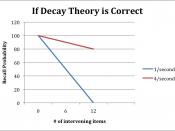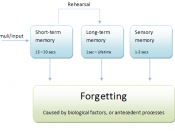Forgetting is an inevitable part of life which the majority of us experience on a day to day basis. What we forget is often specific to a particular person; however, it is why we forget which attracts the attention of psychologists.
To understand how the memory system works, it is important to look at some of the reasons why we loose information. There are several methods to explain this, one of them being displacement. In other words, materials currently circulating in short-term memory which has been insufficiently processed to pass onto the long-term memory, will be pushed out, or displaced by new incoming information. This can be tied with Miller's theory of capacity (Miller's magic number seven). Miller claims that short-term memory has a capacity of only seven items; therefore incoming items will have to displace the existing ones.
Waugh and Norman were two of many psychologists whom investigated the idea of displacement.
They used a serial probe technique, and came to the following conclusions: The chance of recall for an 'early probe' is less than 20%, yet the chance of recall for a 'late probe' is 80%, proving the displacement theory to be correct. However, Shallice (1967) found some conflicting information. He discovered that if the digits were read out faster to a participant, then the probe digit would be easier to remember. This suggests that time may be an important factor in forgetting, which in turn makes it difficult to isolate the effects of displacement from decay.
This brings me to talk about my second explanation of forgetting in short-term memory - decay. This is where the memory trace fades away with time so that the memory is no longer available. It is thought to be some kind of structural change which occurs in the brain when memory...



Short Term Memory.
This is a facinating topic and you covered it very well. You stated your thesis clearly and explained yourself without going into too much detail, which seems appropriate for your intended audience. Great job.
0 out of 0 people found this comment useful.